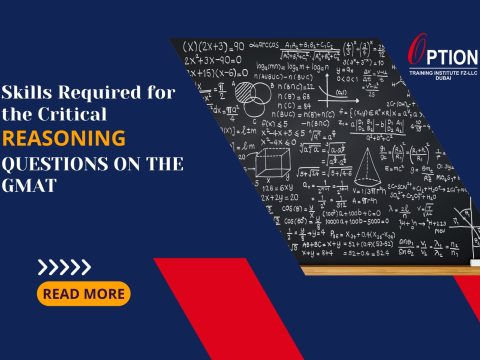- For Enquiry -
- +971 509267126
- +971 551207626
- enquiry@optioneducation.ae
GMAT VERBAL
Critical Reasoning questions on the GMAT arouse a mixed reaction from test takers. While some find these questions easy, others insist they make no sense and are traumatic! Training a group that voices such mixed opinions is challenging and requires trainers to develop class plans to break through mindsets and achieve a more balanced reaction to CR.
The most important thing to learn from a CR class is to start right. It is only possible to read the text of the question by knowing what is being asked of you. Even if this reading takes 3 minutes, it is time squandered.
So, as soon as a CR question appears on the screen, read the task and identify what you are to do – strengthen the conclusion above, undermine the argument above, identify what the speaker is inferring – and what not! Each task requires a different reading style, emphasis, and analytical strategy. With the task clear, moving to the text and sifting it for what is relevant is much simpler.
CR requires precision. In the case study type of questions, especially the task is normally oriented towards some one aspect of the case, and it is necessary that when you review the possible answers, you focus on keeping your eye on that aspect.
If the text has outlined the expansion plans of a business and the task asks you to pick an answer that justifies the ‘financial’ success of the plan, keep the focus. Do not pick any answer that discusses the plan’s benefits; pick the one that zooms in on the ‘financial’ success point.
Reading the task and understanding the language does pose a problem sometimes. This problem seldom arises from the vocabulary used; it arises from the very convoluted and breathlessly long sentences that the GMAT is so good at presenting.
So, while practicing, you would be better off recognizing common words and structures on the test. For example, when the task says “cast doubt on the argument above,” it is the same as “weaken the argument above,” and “additional premise” works the same as an “assumption.”
Becoming familiar with the entire platter of CR question types does work to your advantage. Some very recognizable CR question types – strengthening, weakening, assumption, inference, and conclusion -make up the major portion of the CR questions on the test. At the same time, there are less frequent question types – paradox, bold font, and completing the logic – that normally come in singles but still need to be attended to.
Pay attention to the right answer choices. Most students preparing for the GMAT are concerned with getting the answer right and moving on. It seems reasonable enough, but it needs to be more. There is as much to learn from “why not this answer” as from “why this answer.”
Such inquiry opens the mind, teaches perspectives and possibilities, and helps us explore the fine art of expression. Some answer choices are wrong because of faulty data, others because they are irrelevant, and others because they have used language that has gone overboard or missed the point.
Courses offered at Option Training Institute in Dubai are a learning experience. Unlike the routine training schedules that work around a book and with a few fancy slides, Option’s training schedules help students enjoy the learning process. There are no boxes in the mind; all learning is interdisciplinary and requires curiosity. To encourage this, Option allows students to plan their schedules to maximize learning and minimize stress.
- Filter by
- Categories
- Tags
- Authors
- Show all
- All
- ACT
- ACT Essay
- ACT Exam
- ACT Experts
- ACT Prep
- ACT Preparation
- ACT Test
- ACT Test Takers
- ACT Training
- ACT Writing Section
- Algebra
- AP
- AP AB
- AP BIOLOGY EXAM
- AP Calculus AB
- AP Classes
- AP Course Prep
- AP Dubai
- AP Exam Test
- AP Exams
- AP Test
- c-trap
- Chemistry Subject SAT
- Class Schedules
- Concepts
- COVID 19
- Digital SAT
- DIGITALSAT
- DSAT
- EVEN
- Factors
- GEOMETRY
- gmat
- GMAT MATH
- GMAT Prep
- GMAT Preparation
- gmat quant
- GMAT Scores
- GMAT Section
- gmat test
- GMAT VERBAL
- GMAT Verbal Section
- GRE
- GRE Prep
- GRE Test
- INSEAD
- Junior SAT
- LNAT
- Math
- mathematics
- MBA
- MBA Program
- Multiples
- New SAT
- NEW SAT ESSAY
- Number Properties
- NUMBERS
- Objectives of AP
- ODD
- Option
- QS Event
- Remainders
- SAT
- SAT Biology
- SAT BIOLOGY E/M
- SAT CANCELLATION
- SAT Chemistry Subject Test
- SAT Dubai
- SAT Essay
- SAT Exam
- SAT Grammer
- SAT II
- SAT Language Section
- SAT MATH
- SAT Prep
- SAT READING SECTION
- SAT Subject
- SAT Subject Test
- SAT Test
- SAT Test Takers
- SAT Trainers
- SAT Writing
- SAT Writing Section
- Skills
- Starting Classes
- Subject SAT
- Subject SAT Math Level 2
- Subject Test
- Test Prep
- Test Takers
- Training Institute
- Triangles

